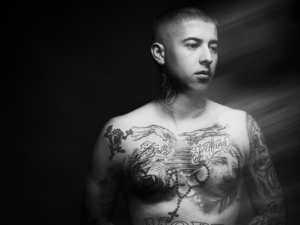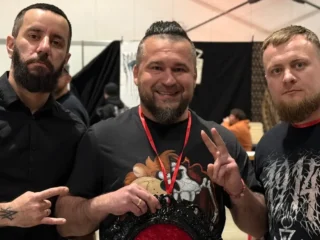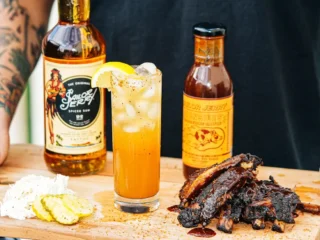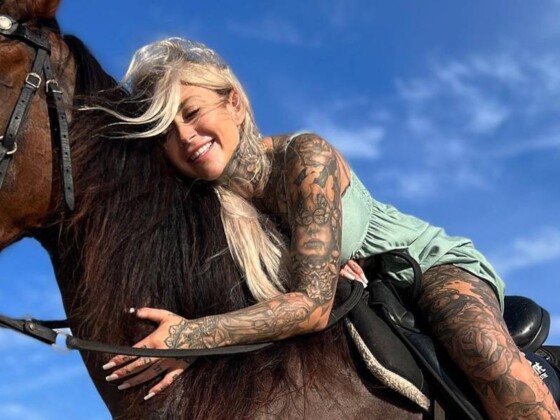Charlie Connell
December 23rd, 2020
Fusing the Flavors of the World
After growing up in the kitchen that brought Pad Thai to America, Jet Tila wants to broaden your culinary horizons one meal at a time.
These days the word “fusion” can be a loaded term, particularly in culinary circles. For years the term has been thrown around as a backhanded description for Americanized Asian dishes. Somewhere along the way the word seemed to lose its actual meaning—the combination of separate things to create a single entity. And there simply is no better word to describe chef Jet Tila’s culinary journey.
It all began with a young Tila stocking shelves in the grocery store his parents owned. After immigrating to the United States in the ’60s, Tila’s parents opened Bangkok Market in 1972. “It was the first Thai grocery store in the history of America,” Tila explains. “We existed in a time where fusion cuisine was gaining popularity. Every single famous restaurant and chef in Los Angeles, from Puck to Joachim at Patina, everyone shopped at our grocery store. It was the only place to get all of these things that were exotic back then—Thai curry paste, coconut milk, etc.
“I was stocking the shelves and I got to do all the deliveries to those restaurants,” Tila continues. “So I formed a very early relationship with so many of what became my peers. I was the kid that helped them with their Asian groceries.”

With his family running a series of restaurants in addition to the grocery store, Tila found himself working in a kitchen at a very young age. But his career didn’t follow a straight line—he needed to go out and have some adventures before finding his way. After dropping out of high school and taking some classes at community college, Tila was a typical 22-year-old desperately trying to find a way to pay the bills without working in his family’s restaurants. Then he came up with a novel idea.
“I started teaching cooking classes out of my backyard because I needed cash,” Tila says. “I would put on the white coat, have people over, and I’d teach them Thai food. There was no Food Network at the time, there weren’t any recreational cooking classes. I was on the ground floor of that. The L.A. Times got a hold of it and wrote a full-page article about it. The demand that article created was the spark I needed to push me into formalizing my education.”
Given the simple fact that he was already teaching very popular cooking classes, on the surface level it seems odd that culinary school would even be a consideration. While he was at an age when we tend to be more than a little headstrong, Tila was wise enough to not only know what he knew, but to recognize all of the things that he didn’t know. “Culinary languages are unique, and every culture evolves differently depending on their influences,” Tila explains. “Ironically, I had never baked a cake from scratch but I had made hundreds of Chinese and Thai dishes. I’d never made a turkey. I’d never made the mother sauces.“Yes, I had a leg up because I touched food and cooked food from a very young age,” Tila continues. “I started my 10,000 hours early, but it wasn’t focused and it wasn’t formal.”
Tila wanted to be thorough, so he attended both French and Japanese culinary schools, then went to work in fine dining. His education helped him become a metaphorical Swiss Army knife in the kitchen—he has the perfect tool for any situation. For example, by learning French techniques and terms, Tila gave himself a common language he is able to share with chefs from all different specialities.
With all of his training and his impressive resume, not to mention his ability to rise to the challenge in the televised pressure cooker that is competitive cooking shows, Tila has proven his breadth of cooking knowledge. While he is capable of making some of the most complex dishes in the world, when given his druthers, Tila’s likely to make something far more humble.

“I’m simple—the five-spice, braised pork trotters,” Tila says. “That’s the dish my grandma made cause we were poor as shit. You could buy pigs feet for 25 cents a pound cause no one wanted them. She braised them up and we ate them over white rice. Ginger, five spice, the gelatin… it’s incredible.”
Grandma’s trotters, and many of the foods he was raised on, take up a lot of real estate in Tila’s mental cookbook. Los Angeles is one of the great melting pots of this nation and it left its mark on the chef. “I grew up in this awesome little strip between Chinatown, Little Tokyo, Little Armenia and Little El Salvador,” Tila explains. “I’m really that five flavor kinda dude. Hot sour, salty, sweet and savory have to exist in everything I’m eating. I need to have the balance of all those flavors all the time. Every day I need to have big flavors in combination.”
Tila started getting tattooed when he was 18. Like so many 18-year-olds, he had an idea that seemed perfect at the time, but instead of aging like a fine wine, that first tattoo has aged more like the lager beer it depicts. “I got a Singh, which in Thai means ‘tiger,’” Tila says of the beer company’s logo tattooed on his arm. “It makes no sense. When I walk around Asia people laugh at me because it’s basically like having a Coca Cola or Pepsi logo on you. I just thought it was cool and I was rushing, I was dying to get my first tattoo. It’s still there on my right upper arm and I’m not going to cover it over. It just reminds me we’re all young and dumb and whatever [laughs].
“When I’m hanging out in America people are like, ‘Cool tattoo, that thing’s dope,’” Tila continues. “And then when you’re in Thailand they’re like, ‘What the fuck are you thinking, dude? They better be paying you.’”
While Tila has refused to get any of the stereotypical “chef tattoos”—we’re talking to you, chef’s knife forearm tattoo—he does believe that one of his tattoos embodies his profession. On Tila’s left arm is a depiction of the traditional koi folk tale. “The koi is very representative of most chefs,” he explains. “I would say the majority of us are vagabonds, rebels and nonconformists. We all know the story of the koi—a stubborn animal that pushes its way upstream to, hopefully, become the dragon.”
It took a lot of hard work and determination, but Tila has made it, just like the koi turning into a dragon on his arm.

Editor's Picks
Royal & The Serpent
The hilarious and talented musician talks mental health, music, tattoos and more
Son of a Sinner
From rough-and-tumble roots to mainstream stardom, this genre-crossing musician is on a roll
A Cut Above
Celebrated barber Vic Blends can charge whatever he wants for a haircut, but all he really wants in exchange is a conversation and human connection














